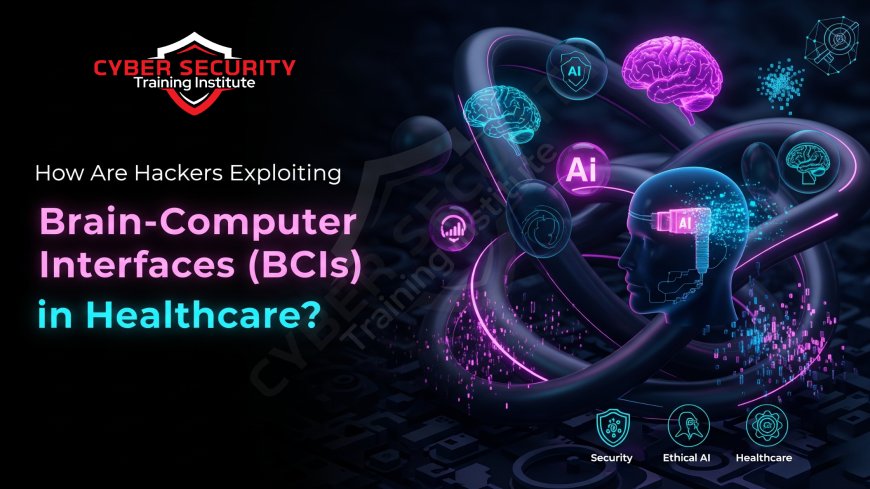How Are Hackers Exploiting Brain-Computer Interfaces (BCIs) in Healthcare?
In 2025, Brain-Computer Interfaces (BCIs) are a medical miracle, but they also represent the final frontier in cybersecurity, creating the most personal attack surface imaginable. This in-depth article explores the emerging methods hackers are using to exploit these life-changing healthcare devices. We delve into the new categories of threat, including "neural eavesdropping" to intercept a user's intentions, "malicious input injection" to hijack control of prosthetic limbs, and the rise of "cognitive ransomware," where an attacker can hold a patient's restored abilities hostage. The piece features a comparative analysis of traditional medical device hacking versus the unique and intimate threats posed by BCIs. We also provide a focused case study on how Pune's cutting-edge neuroscience and HealthTech research centers are on the front lines of both developing and defending this technology. This is an essential read for anyone in the healthcare, technology, and security sectors seeking to understand the profound new challenges of protecting the privacy and autonomy of the human mind in an increasingly connected world.

Introduction: The Most Personal Attack Surface
Brain-Computer Interfaces (BCIs) are one of the most profound medical technologies of our time. They are turning science fiction into reality, offering the promise of restoring movement to the paralyzed, communication to the "locked-in," and control to those with severe neurological disorders. But this incredible fusion of mind and machine, the most intimate connection between human and computer ever created, also opens up the most personal and dangerous attack surface imaginable. As we stand here in 2025, with BCI technology moving from research labs into clinical practice, it is inevitably appearing on the radar of sophisticated cybercriminals. Hackers are beginning to exploit Brain-Computer Interfaces by targeting the entire system—from the wireless signals to the AI decoders—to intercept neural data, manipulate physical actions, and hold a person's very cognitive autonomy for ransom. This isn't just a new vector for data theft; it's a new category of threat aimed at the core of human identity.
The BCI Attack Surface: A Direct Line to the Brain
To understand the risks, you first have to understand the components of a typical medical BCI system. It's a chain of technology where every link is a potential vulnerability.
- The Sensors: These are the electrodes that read the brain's electrical signals. They can be non-invasive, like an EEG cap worn on the head, or invasive, like an ECoG grid surgically placed on the surface of the brain. While hacking the sensor itself is difficult, its signals can be jammed.
- The Processing Unit: This is the "brain" of the BCI. It's a small, powerful computer—either worn externally or implanted—that runs the AI algorithms needed to translate the noisy, raw brainwave data into clear, digital commands. This processor is a primary target for malware.
- The Wireless Link: For a patient to have freedom of movement, most modern BCIs use a wireless protocol (like a specialized form of Bluetooth or Wi-Fi) to send the digital commands from the processing unit to the device being controlled. This wireless link is a classic weak point, vulnerable to eavesdropping and hijacking.
- The Controlled Device: This is the end device that performs the action, such as a robotic prosthetic arm, a motorized wheelchair, or a speech-synthesis computer. Each of these is itself a complex computer system that can be hacked.
.
"Brain-Hacking": Interception and Manipulation of Neural Data
The most futuristic, and most alarming, threats involve the direct compromise of the neural data stream itself. This is often sensationalized as "mind reading," but the reality in 2025 is more nuanced, yet still deeply concerning.
- Neural Eavesdropping: By launching a man-in-the-middle attack on the wireless link or by compromising the processing unit, an attacker could intercept the stream of translated neural commands. They may not be able to "read your thoughts" like a book, but the AI models used in these attacks can be reverse-engineered. An attacker could train their own AI to recognize the neural patterns associated with specific intended movements, subvocalized words, or even basic emotional states. For a political dissident or a corporate executive, the risk of having their unfiltered intentions spied on is a profound threat.
- Malicious Input Injection: This is a more immediate and physically dangerous threat. Instead of just reading the data, an attacker can write to it. They could send false commands to the BCI system. For a patient with a prosthetic arm, this could cause the limb to spasm, drop things, or move uncontrollably. For a patient using a BCI to control their wheelchair, an attacker could hijack their movement, with potentially lethal consequences. It could also be used to put false words in the mouth of a patient who uses a BCI for communication, a terrifying form of identity theft.
Comparative Analysis: Traditional Medical Device vs. BCI Hacking
While we have dealt with the hacking of medical devices like insulin pumps for years, the exploitation of BCIs represents a fundamentally different and more intimate category of threat.
| Threat Vector | Traditional Medical Device Hacking (e.g., Insulin Pump) | BCI Hacking (2025) |
|---|---|---|
| Targeted System | Attacks a device that regulates an autonomous biological function, like insulin delivery or a heart's rhythm. | Attacks a device that interprets and acts on a user's conscious, direct neural intent. It targets the user's will. |
| Primary Attack Goal | To manipulate the device to cause direct, often covert, physical harm (e.g., a fatal overdose of insulin). | To seize control of a user's ability to interact with the world, cause overt physical harm, and perform neural eavesdropping. |
| Data Risk | Theft of stored Personal Health Information (PHI) and historical device logs from a server. | Theft of the real-time, raw neural data stream, which could be used to infer a user's intentions, cognitive state, or subvocalized thoughts. |
| Psychological Impact | Causes fear and uncertainty about the safety and reliability of a medical device. | Creates a profound sense of personal violation and the complete loss of bodily autonomy, as the attack targets the user's very thoughts. |
| Key Vulnerability | Primarily insecure wireless protocols and unpatched device firmware. | Includes all traditional vulnerabilities, plus the AI-powered neural decoding models themselves as a new, highly complex attack surface. |
Denial of Service and the Rise of "Cognitive Ransomware"
Some of the most effective attacks on BCIs are terrifying new versions of classic cyberattacks. A Denial-of-Service (DoS) attack in this context is not just an inconvenience; it's a direct assault on the patient's restored abilities. An attacker could use a simple radio jamming device to flood the BCI's wireless channel, instantly severing the connection between the patient's brain and their prosthetic limb or communication device. For a patient who has regained a semblance of independence through this technology, this is the digital equivalent of being bound and gagged.
This leads to the grim, but inevitable, evolution: "Cognitive Ransomware." An attacker could launch a DoS attack and then deliver a ransom note, not to a computer screen, but perhaps through a message to a family member. The demand is simple and cruel: "Pay us 10 Lakhs, or your mother remains unable to speak." This form of extortion targets the deep emotional and physical dependency a patient has on their BCI, creating an immense pressure to pay. A second form of this could involve an attacker who has performed neural eavesdropping threatening to release the deeply private and sensitive neural data they have collected unless a ransom is paid.
Pune's HealthTech and Neuroscience Research Scene on the Front Line
Pune's reputation as a national center for healthcare, with its world-class hospitals and thriving pharmaceutical industry, has made it a natural hub for cutting-edge medical R&D. In 2025, the city is home to a growing number of innovative HealthTech startups and neuroscience research centers that are at the forefront of developing and testing the next generation of BCI technologies. Prestigious hospitals in the city are among the first in the nation to be running the highly sensitive clinical trials for these life-changing devices.
This position, however, places Pune's medical and research community directly in the crosshairs of these new threats. The intellectual property and patient data from these BCI clinical trials are incredibly valuable targets for corporate spies and nation-state actors. An attacker might target a Pune-based research institute not just to steal the groundbreaking designs for a new neural implant, but to actively sabotage a clinical trial. By hacking a BCI being used by a trial patient, they could cause a device to malfunction, potentially harming the patient and discrediting the entire field of research, thereby setting back a competitor's progress for years. For Pune's innovators, securing these trials against such advanced threats is a paramount ethical and commercial challenge.
Conclusion: Protecting the Privacy of the Mind
The exploitation of Brain-Computer Interfaces is the next, and perhaps final, frontier of cybersecurity. It moves the attack surface from our external digital devices to the very core of our consciousness. The threats of malicious control, neural eavesdropping, and cognitive ransomware are no longer theoretical possibilities but are emerging risks that we must confront as this technology becomes more common. Defending against these threats requires an unprecedented level of security and collaboration. Neuroscientists, hardware engineers, AI specialists, and cybersecurity experts must work together to build a new security paradigm for BCIs. This new model has to be built on a foundation of heavily encrypted and authenticated wireless communications, robust hardware-level security for the processing units, and a new generation of defensive AI that can distinguish between a patient's normal brain activity and a malicious, injected command. To ensure that BCI technology fulfills its incredible promise, we must secure it with the highest level of diligence, protecting not just data, but the autonomy and privacy of the human mind itself.
Frequently Asked Questions
What is a Brain-Computer Interface (BCI)?
A BCI is a technology that allows a person to control an external device, like a computer or a prosthetic limb, using only their brain signals, without any muscular movement.
How does a BCI read brainwaves?
It uses sensors, either non-invasive (like an EEG cap with electrodes on the scalp) or invasive (like an ECoG grid on the brain's surface), to detect the tiny electrical signals generated by neurons firing in the brain.
Can a hacker actually read my thoughts?
Not in the sense of reading complex, abstract thoughts like a book. However, in 2025, the technology is at a point where an attacker who intercepts the data stream might be able to use AI to decode the neural patterns for specific motor intentions or subvocalized words.
What is "neural eavesdropping"?
This refers to the unauthorized interception and analysis of a person's neural data stream from a BCI, with the goal of inferring their intentions, cognitive state, or the content of their communication.
What is "cognitive ransomware"?
This is a new form of ransomware where an attacker disables a patient's BCI functionality (e.g., their ability to move a prosthetic or to speak) and demands a ransom payment to restore it.
What is the biggest security risk in a BCI system?
The wireless communication link between the internal processing unit and the external device it controls is often considered the most vulnerable point, as it is susceptible to interception and hijacking (man-in-the-middle attacks).
Why is Pune's medical research a target?
Because Pune is a hub for advanced HealthTech and neuroscience research, including BCI clinical trials. The data and intellectual property from these trials are extremely valuable to corporate and national adversaries.
What is EEG and ECoG?
EEG (electroencephalography) is a non-invasive method of recording brain activity using scalp electrodes. ECoG (electrocorticography) is an invasive method that uses electrodes placed directly on the surface of the brain, providing a much higher quality signal.
How can a prosthetic arm be hacked?
An attacker could compromise the wireless signal that sends commands to the arm, allowing them to send their own malicious commands to make the arm move uncontrollably, spasm, or shut down.
Is this threat real today in 2025?
Yes. While BCI technology is not yet widespread, it is in active clinical use. The vulnerabilities are real, and security researchers have demonstrated these attacks in laboratory settings. The attacks are expected to grow as the technology becomes more common.
How do you defend a BCI?
Defense requires a multi-layered approach: strong, end-to-end encryption on all wireless signals, hardware-level security on the processing units, and AI-powered anomaly detection to spot malicious commands that look different from the patient's normal brain patterns.
What is a "man-in-the-middle" attack?
It's an attack where a hacker secretly intercepts and relays communications between two parties. In a BCI context, they would place themselves between the BCI's transmitter and the prosthetic's receiver.
Does this affect non-medical BCIs, like for gaming?
Absolutely. The risks are similar. An attacker could try to intercept data from a gaming BCI to cheat, or they could try to inject signals to interfere with the user's gameplay.
What is a "subvocalized word"?
This refers to a word that a person says in their mind without actually speaking it aloud. Advanced BCIs are beginning to be able to decode the neural signals for these subvocalizations to restore speech.
What is Personal Health Information (PHI)?
PHI is any information in a medical record that can be used to identify an individual. Neural data from a BCI is considered an extremely sensitive form of PHI.
Are there laws to protect this kind of data?
Yes, medical data is protected by laws like HIPAA in the US and the Digital Personal Data Protection Act (DPDPA) in India. However, the unique nature of neural data is creating new legal and ethical challenges.
Who is most at risk from these attacks?
High-profile individuals (like politicians or executives) who may use BCI technology in the future would be prime targets for espionage. However, any patient who relies on a BCI for their daily function is at risk from ransomware or disruptive attacks.
What is a "locked-in" patient?
Locked-in syndrome is a condition where a patient is aware but cannot move or communicate verbally due to complete paralysis of nearly all voluntary muscles. BCIs offer a way for these patients to communicate.
Can the AI in a BCI be poisoned?
It's theoretically possible. An attacker with long-term access could try to subtly manipulate the signals to "retrain" the BCI's decoding AI, leading to a degradation in performance or incorrect actions. This is a form of data poisoning.
What is the most important thing for BCI manufacturers to focus on?
Security-by-design. Security cannot be an afterthought; it must be a core design principle from the very first stage of developing any new BCI system, from the chip level to the wireless protocol to the AI model.
What's Your Reaction?
 Like
0
Like
0
 Dislike
0
Dislike
0
 Love
0
Love
0
 Funny
0
Funny
0
 Angry
0
Angry
0
 Sad
0
Sad
0
 Wow
0
Wow
0















